2022 TOYOTA SUPRA deactivate passenger airbag
[x] Cancel search: deactivate passenger airbagPage 125 of 498
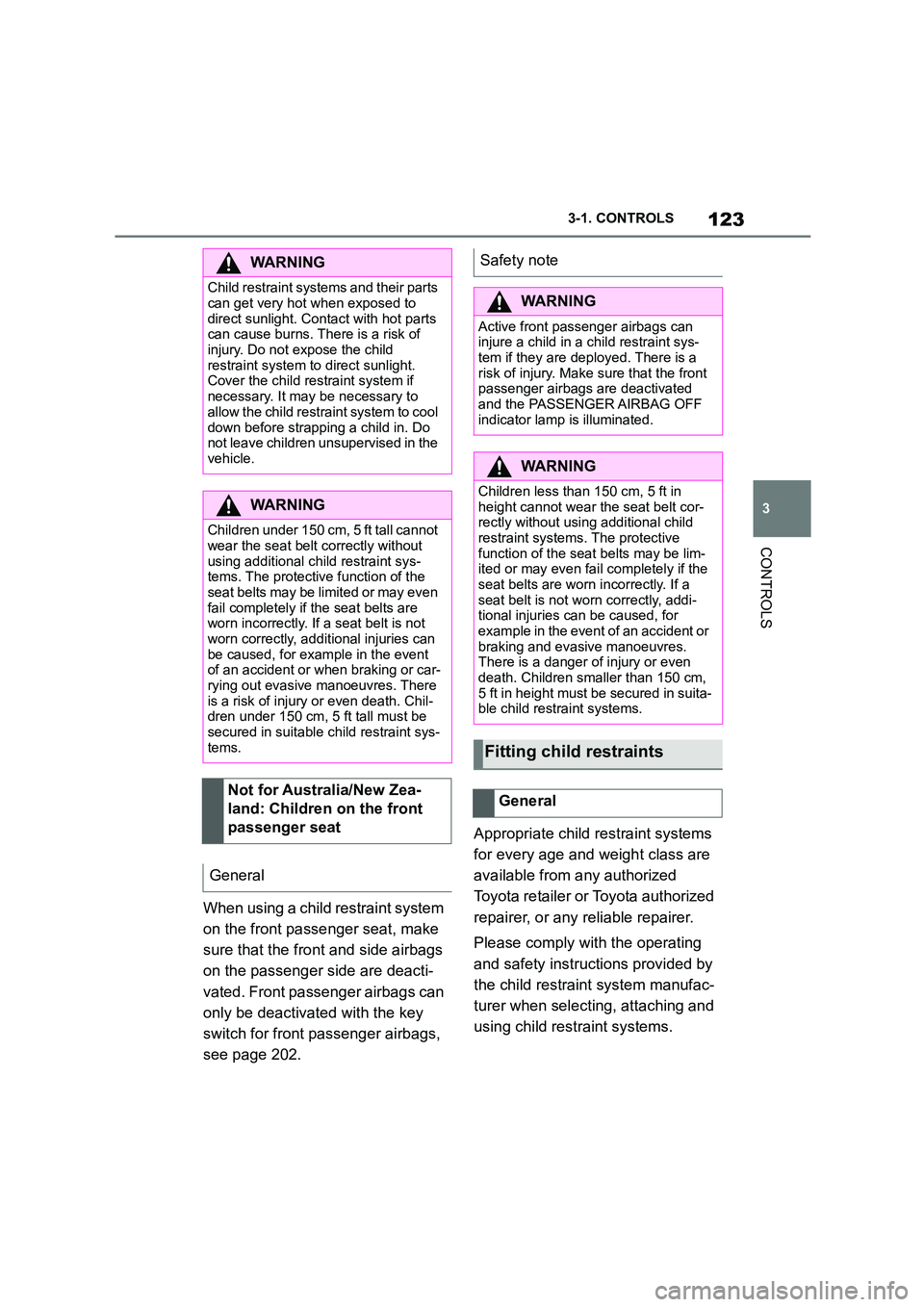
123
3
3-1. CONTROLS
CONTROLS
When using a child restraint system
on the front passenger seat, make
sure that the front and side airbags
on the passenger side are deacti-
vated. Front passenger airbags can
only be deactivated with the key
switch for front passenger airbags,
see page 202.
Appropriate child restraint systems
for every age and weight class are
available from any authorized
Toyota retailer or Toyota authorized
repairer, or any reliable repairer.
Please comply with the operating
and safety instructions provided by
the child restraint system manufac-
turer when selecting, attaching and
using child restraint systems.
WA R N I N G
Child restraint systems and their parts
can get very hot when exposed to
direct sunlight. Contact with hot parts can cause burns. There is a risk of
injury. Do not expose the child
restraint system to direct sunlight. Cover the child restraint system if
necessary. It may be necessary to
allow the child restraint system to cool
down before strapping a child in. Do not leave children unsupervised in the
vehicle.
WA R N I N G
Children under 150 cm, 5 ft tall cannot
wear the seat belt correctly without
using additional child restraint sys- tems. The protective function of the
seat belts may be limited or may even
fail completely if the seat belts are worn incorrectly. If a seat belt is not
worn correctly, additional injuries can
be caused, for example in the event of an accident or when braking or car-
rying out evasive manoeuvres. There
is a risk of injury or even death. Chil-
dren under 150 cm, 5 ft tall must be secured in suitable child restraint sys-
tems.
Not for Austra lia/New Zea-
land: Children on the front
passenger seat
General
Safety note
WA R N I N G
Active front passenger airbags can
injure a child in a child restraint sys- tem if they are deployed. There is a
risk of injury. Make sure that the front
passenger airbags are deactivated and the PASSENGER AIRBAG OFF
indicator lamp is illuminated.
WA R N I N G
Children less than 150 cm, 5 ft in height cannot wear the seat belt cor-
rectly without using additional child
restraint systems. The protective function of the seat belts may be lim-
ited or may even fail completely if the
seat belts are worn incorrectly. If a seat belt is not worn correctly, addi-
tional injuries can be caused, for
example in the event of an accident or braking and evasive manoeuvres.
There is a danger of injury or even
death. Children smaller than 150 cm,
5 ft in height must be secured in suita- ble child restraint systems.
Fitting child restraints
General
Page 126 of 498
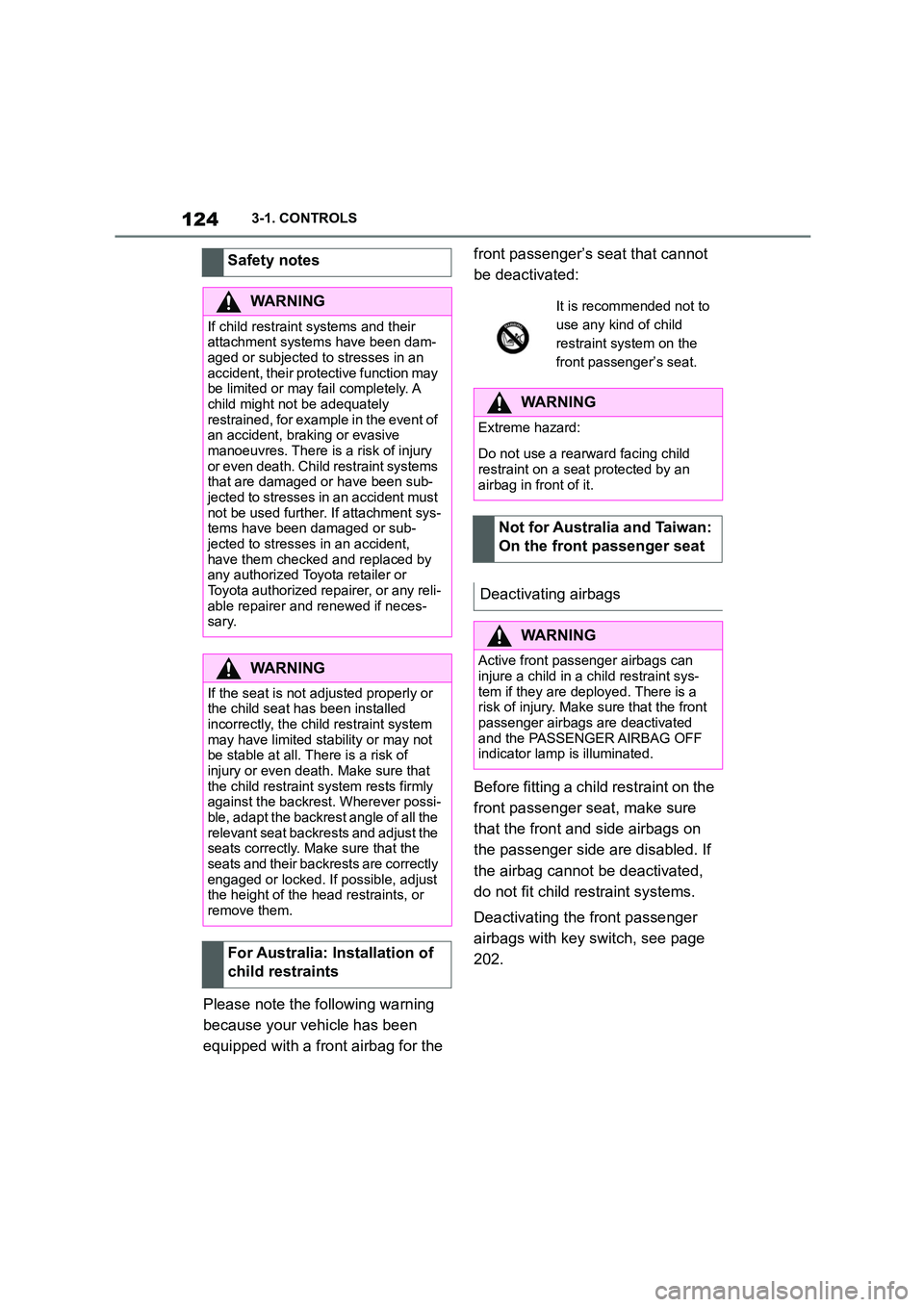
1243-1. CONTROLS
Please note the following warning
because your vehicle has been
equipped with a front airbag for the
front passenger’s seat that cannot
be deactivated:
Before fitting a child restraint on the
front passenger seat, make sure
that the front and side airbags on
the passenger side are disabled. If
the airbag cannot be deactivated,
do not fit child restraint systems.
Deactivating the front passenger
airbags with key switch, see page
202.
Safety notes
WA R N I N G
If child restraint systems and their
attachment system s have been dam- aged or subjected to stresses in an
accident, their protective function may
be limited or may fail completely. A child might not be adequately
restrained, for example in the event of
an accident, braking or evasive
manoeuvres. There is a risk of injury or even death. Child restraint systems
that are damaged or have been sub-
jected to stresses in an accident must not be used further. If attachment sys-
tems have been damaged or sub-
jected to stresses in an accident, have them checked and replaced by
any authorized Toyota retailer or
Toyota authorized repairer, or any reli- able repairer and renewed if neces-
sary.
WA R N I N G
If the seat is not adjusted properly or the child seat has been installed
incorrectly, the chil d restraint system
may have limited stability or may not be stable at all. There is a risk of
injury or even death. Make sure that
the child restraint system rests firmly against the backrest. Wherever possi-
ble, adapt the backrest angle of all the
relevant seat backrests and adjust the seats correctly. Make sure that the
seats and their backrests are correctly
engaged or locked. If possible, adjust the height of the head restraints, or
remove them.
For Australia: In stallation of
child restraints
It is recommended not to
use any kind of child
restraint system on the
front passenger’s seat.
WA R N I N G
Extreme hazard:
Do not use a rearward facing child
restraint on a seat protected by an airbag in front of it.
Not for Australia and Taiwan:
On the front passenger seat
Deactivating airbags
WA R N I N G
Active front passenger airbags can
injure a child in a child restraint sys-
tem if they are deployed. There is a
risk of injury. Make sure that the front passenger airbags are deactivated
and the PASSENGER AIRBAG OFF
indicator lamp is illuminated.
Page 127 of 498
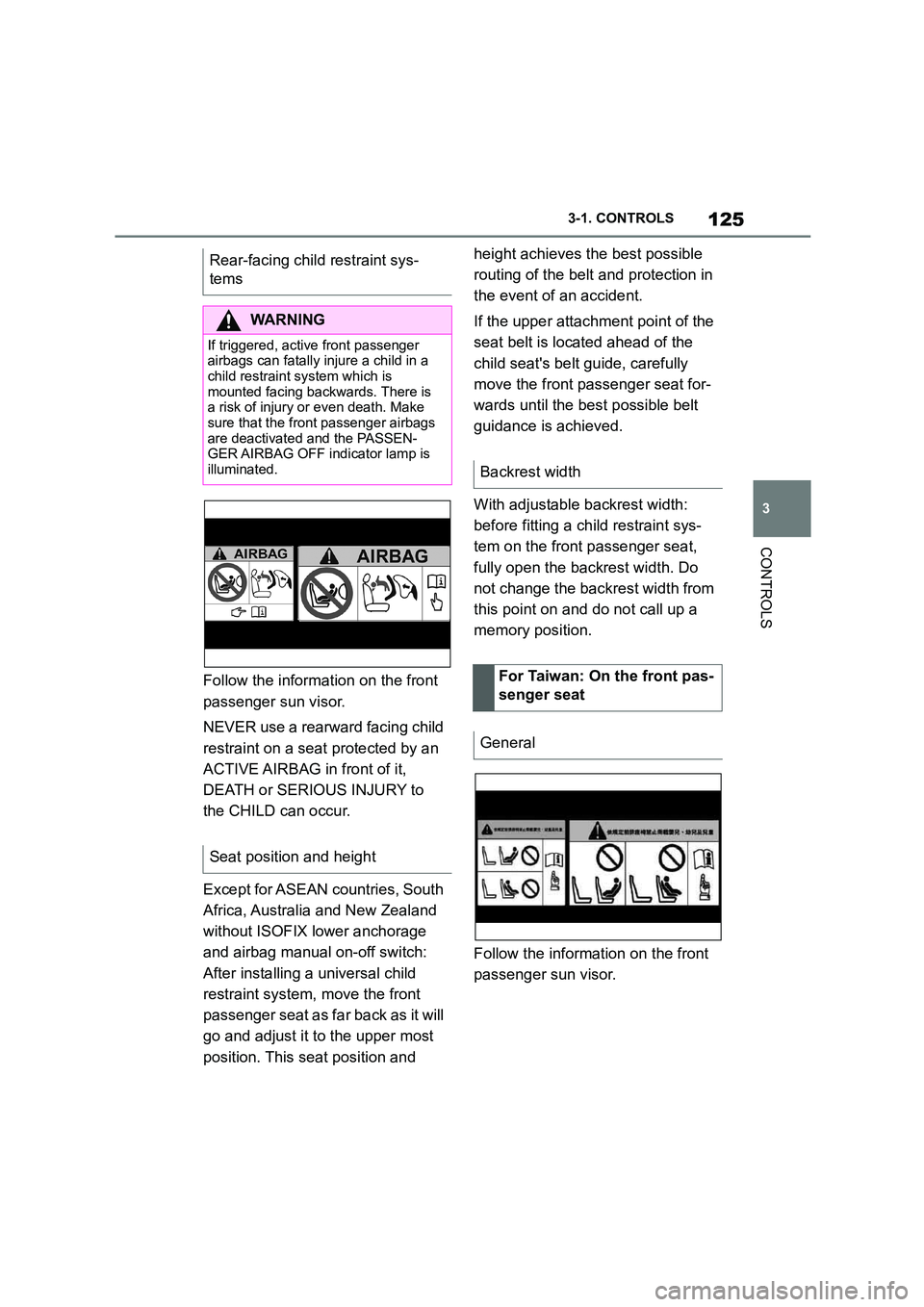
125
3
3-1. CONTROLS
CONTROLS
Follow the information on the front
passenger sun visor.
NEVER use a rearwa rd facing child
restraint on a seat protected by an
ACTIVE AIRBAG in front of it,
DEATH or SERIOUS INJURY to
the CHILD can occur.
Except for ASEAN countries, South
Africa, Australia and New Zealand
without ISOFIX lower anchorage
and airbag manual on-off switch:
After installing a universal child
restraint system, move the front
passenger seat as fa r back as it will
go and adjust it to the upper most
position. This seat position and
height achieves the best possible
routing of the belt and protection in
the event of an accident.
If the upper attachment point of the
seat belt is located ahead of the
child seat's belt guide, carefully
move the front passenger seat for-
wards until the best possible belt
guidance is achieved.
With adjustable backrest width:
before fitting a child restraint sys-
tem on the front passenger seat,
fully open the backrest width. Do
not change the backrest width from
this point on and do not call up a
memory position.
Follow the informat ion on the front
passenger sun visor.
Rear-facing child restraint sys-
tems
WA R N I N G
If triggered, active front passenger
airbags can fatally injure a child in a child restraint system which is
mounted facing backwards. There is
a risk of injury or even death. Make
sure that the front passenger airbags are deactivated and the PASSEN-
GER AIRBAG OFF indicator lamp is
illuminated.
Seat position and height
Backrest width
For Taiwan: On the front pas-
senger seat
General
Page 128 of 498
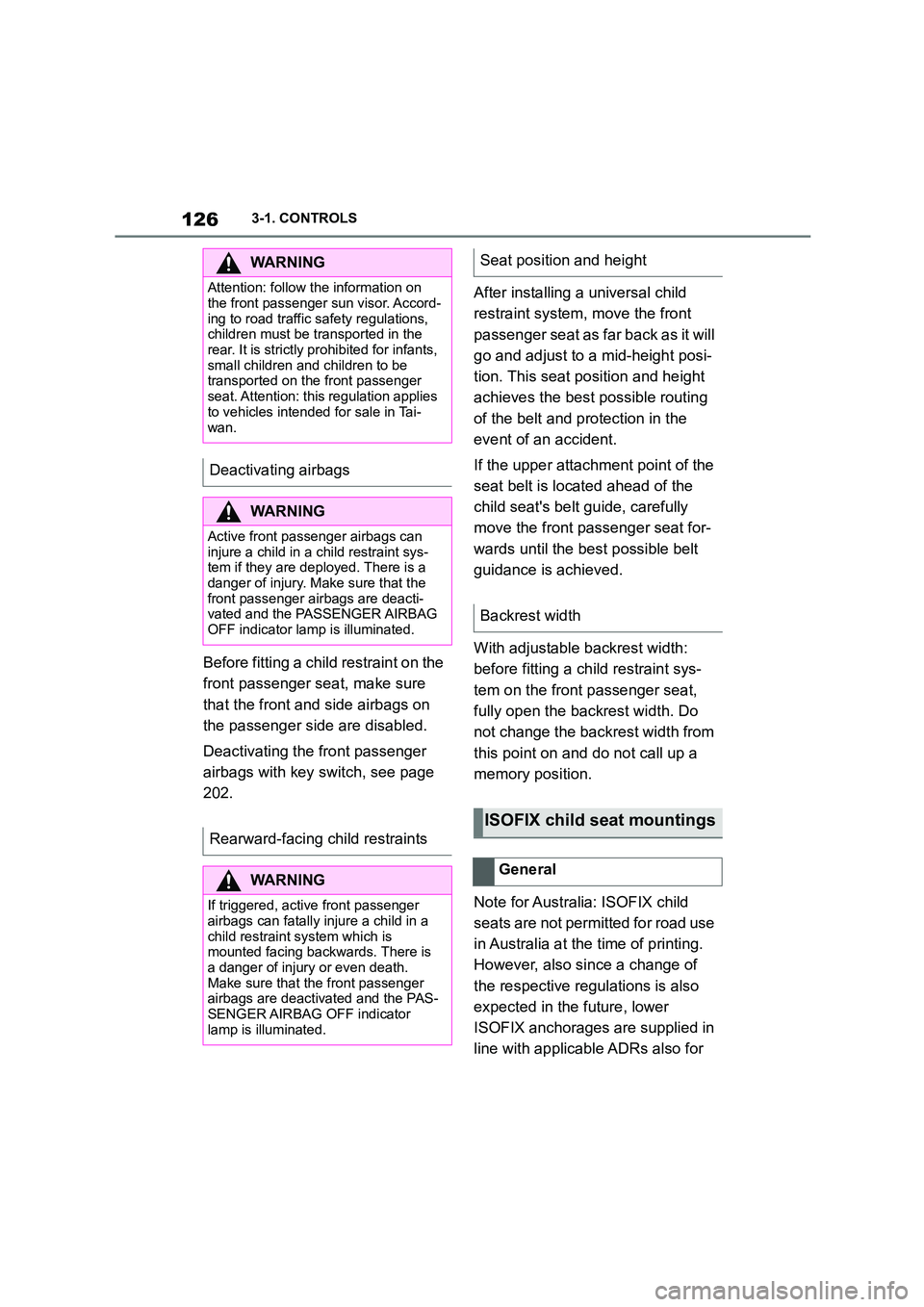
1263-1. CONTROLS
Before fitting a child restraint on the
front passenger seat, make sure
that the front and side airbags on
the passenger side are disabled.
Deactivating the front passenger
airbags with key switch, see page
202.
After installing a universal child
restraint system, move the front
passenger seat as far back as it will
go and adjust to a mid-height posi-
tion. This seat position and height
achieves the best possible routing
of the belt and protection in the
event of an accident.
If the upper attachment point of the
seat belt is located ahead of the
child seat's belt guide, carefully
move the front passenger seat for-
wards until the best possible belt
guidance is achieved.
With adjustable backrest width:
before fitting a child restraint sys-
tem on the front passenger seat,
fully open the backrest width. Do
not change the backrest width from
this point on and do not call up a
memory position.
Note for Australia: ISOFIX child
seats are not permitted for road use
in Australia at the time of printing.
However, also since a change of
the respective regulations is also
expected in the future, lower
ISOFIX anchorages are supplied in
line with applicable ADRs also for
WA R N I N G
Attention: follow the information on
the front passenger sun visor. Accord-
ing to road traffic safety regulations, children must be transported in the
rear. It is strictly prohibited for infants,
small children and children to be transported on the front passenger
seat. Attention: this regulation applies
to vehicles intended for sale in Tai-
wan.
Deactivating airbags
WA R N I N G
Active front passenger airbags can
injure a child in a child restraint sys- tem if they are deployed. There is a
danger of injury. Make sure that the
front passenger airbags are deacti- vated and the PASSENGER AIRBAG
OFF indicator lamp is illuminated.
Rearward-facing child restraints
WA R N I N G
If triggered, active front passenger
airbags can fatally injure a child in a
child restraint system which is
mounted facing backwards. There is a danger of injury or even death.
Make sure that the front passenger
airbags are deactivated and the PAS- SENGER AIRBAG OFF indicator
lamp is illuminated.
Seat position and height
Backrest width
ISOFIX child seat mountings
General
Page 205 of 498
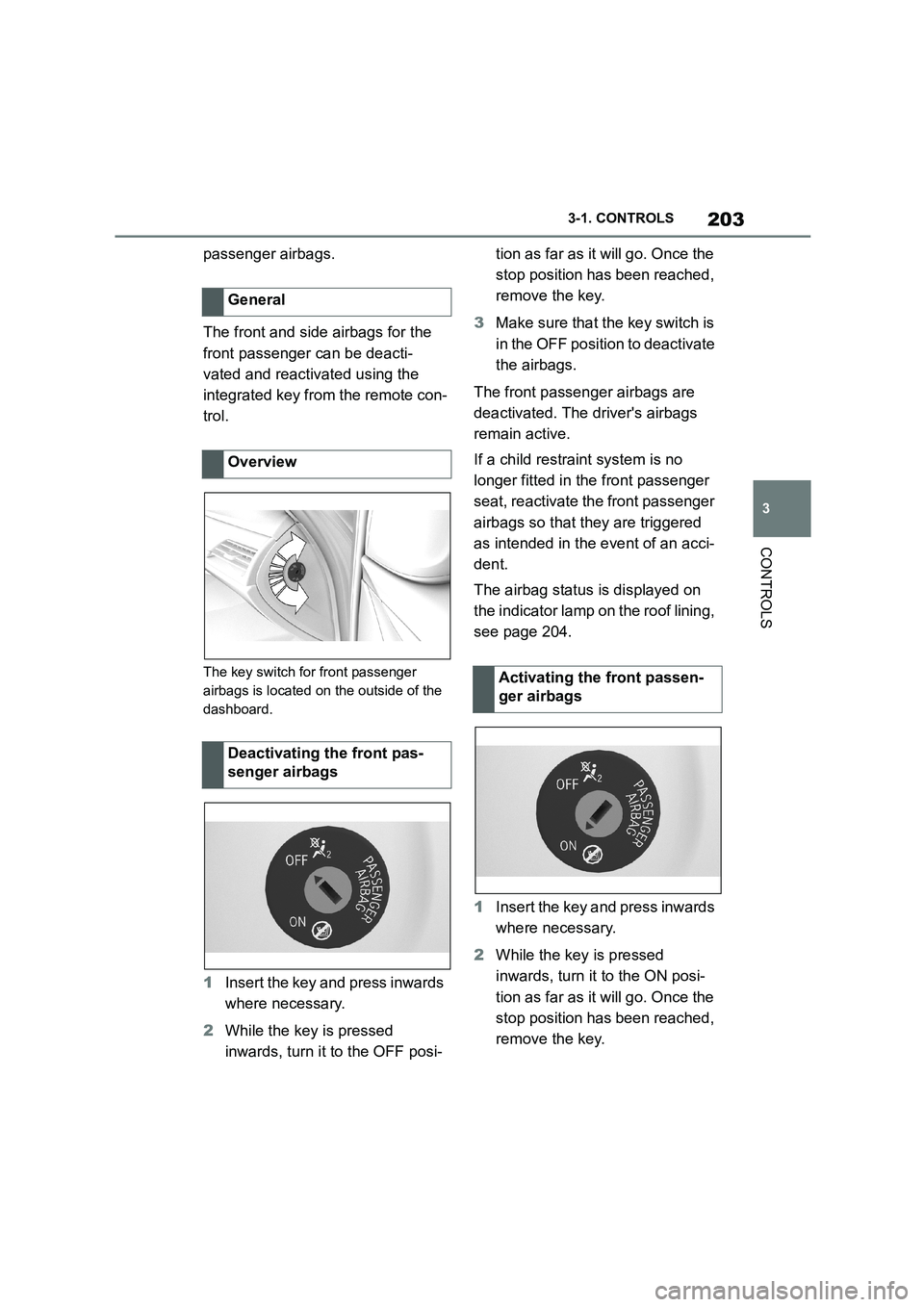
203
3
3-1. CONTROLS
CONTROLS
passenger airbags.
The front and side airbags for the
front passenger can be deacti-
vated and reactivated using the
integrated key from the remote con-
trol.
The key switch for front passenger
airbags is located on the outside of the
dashboard.
1 Insert the key and press inwards
where necessary.
2 While the key is pressed
inwards, turn it to the OFF posi-
tion as far as it will go. Once the
stop position has been reached,
remove the key.
3 Make sure that the key switch is
in the OFF position to deactivate
the airbags.
The front passenger airbags are
deactivated. The driver's airbags
remain active.
If a child restraint system is no
longer fitted in the front passenger
seat, reactivate the front passenger
airbags so that they are triggered
as intended in the event of an acci-
dent.
The airbag status is displayed on
the indicator lamp on the roof lining,
see page 204.
1 Insert the key and press inwards
where necessary.
2 While the key is pressed
inwards, turn it to the ON posi-
tion as far as it will go. Once the
stop position has been reached,
remove the key.
General
Overview
Deactivating the front pas-
senger airbags
Activating the front passen-
ger airbags
Page 206 of 498

2043-1. CONTROLS
3Make sure that the key switch is
in the ON position to activate the
airbags.
The front passenger airbags are
reactivated and can deploy cor-
rectly if the need arises.
The indicator lamp for the front pas-
senger airbags in the roof lining
shows the operating status of the
front passenger airbags.
After switching on the drive-ready
state, the light illuminates briefly
and then shows whether the
airbags are activated or deacti-
vated.
*: if equipped
The active pedestrian protection
system raises the bonnet if the
vehicle's front end collides with a
pedestrian. Sensors underneath
the bumper are used for detection.
When the pedestrian protection
system is triggered, it creates
deformation space underneath the
bonnet for the subsequent head
impact.
Indicator lamp for front pas-
senger airbags
DisplayFunction
If the front passenger
airbag is activated, the
indicator lamp illuminates
for a short period and then
extinguishes.
When front passenger
airbags are deactivated,
the indicator lamp remains
illuminated.
Active pedestrian protec-
tion*
Principle
General
Safety notes
WA R N I N G
The system can trigger inadvertently if contact is made with individual com-
ponents of the hinges and bonnet
locks. There is a danger of injury or damage to property. Do not touch
individual components of the hinges
and bonnet locks.
WA R N I N G
Modifications to the pedestrian pro-
tection system can le ad to a failure, a
malfunction or accidental triggering of the pedestrian protection system.
There is a danger of injury or even
death. Do not modify the pedestrian protection system, its individual com-
ponents or its wiring. Do not disman-
tle the system.